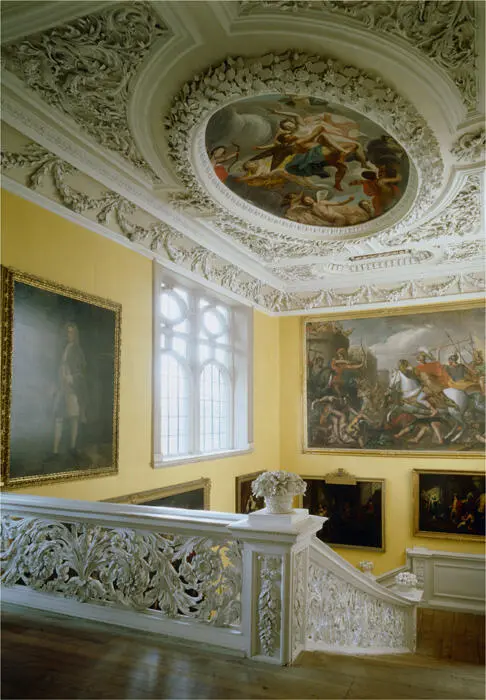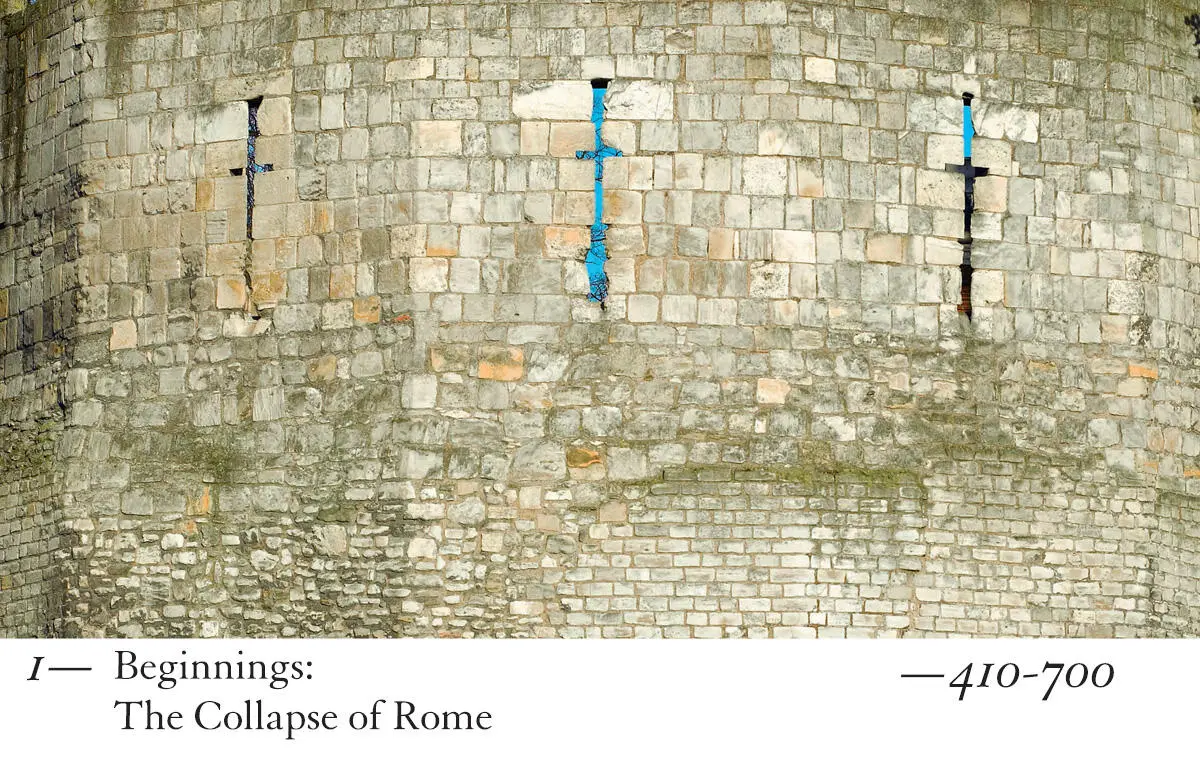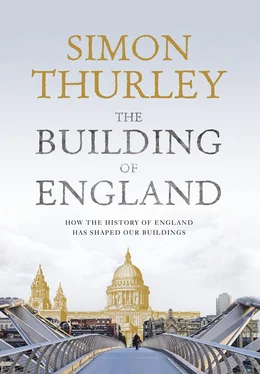On a number of occasions new architectural languages were imported in a measured form that was then embellished and decorated. This reflects an underlying preference for ornamentation. The severity of Norman Winchester Cathedral ( fig. 44), for instance, soon gives way to the exuberance of the nave at Durham Cathedral ( fig. 51), something, perhaps, more florid and native, while the introduction of austere classical forms at Longleat House, Wiltshire (p. 212), turns into the encrustations of a house like Wollaton Hall, Nottinghamshire ( fig. 195).
So there is a pendulum of taste swinging from austerity, simplicity and minimalism to ornament, colour and exuberance, and then back again. The Norman Conquest swept away the decorated buildings of the late Saxons, generating an architecture of military sobriety; but this gave way, in reaction, to the exuberant buildings of the 12th century. The way the English used Gothic from the 1170s was very austere, but this led to its elaboration and decoration from the 1250s. Simplicity of line and cleanness of form began to return in the 1340s, remaining the accepted language until the 1450s, when it became decorated and exuberant again. Towards the end of the reign of Henry VII and lasting until around 1530, simplicity and austerity returned before being overwhelmed by the theatre of Henry VIII’s court architecture. Then there was a short period of austere classical rigour from the 1550s to the 60s before a riot of Elizabethan and Jacobean decoration commenced. By the 1630s the mood swung back to minimalism, which remained to the Restoration until the richness and inventiveness of Wren, Hawksmoor and Vanbrugh become fashionable. Under the influence of Lord Burlington and his approved architects a more tempered and austere classical architecture then took over until the 1760s, when there was an explosion of decorative styles. The simplicity of the Grecian revival in the 1820s was transformed into the richness and colour of revived Renaissance styles in the 1830s. The purity of Gothic Revivalism in the 1840s then led to a riot of expressiveness of High Victorian Gothic in the 1860s, before a return to the simplification of forms of so-called ‘Queen Anne’ from the 1870s. This, in turn, gave way to a revival of interest in baroque forms, which itself stimulated a new breed of minimalist modern classicism.

Sudbury Hall, Derbyshire, built by George Vernon 1660–80. The staircase with remarkable carving and breathtaking plaster-work is at the exuberant end of English architectural taste.
Of course, moderation and excess are not opposites – they can coexist both within architecture and within the human spirit. They are different states of the same mind, not different states of mind. Yet their presence is certainly discernible to a greater or lesser extent through the building history of England. This observation is not a causal analysis nor an explanation of what happened. It is a description of a chain of events. The impulses that caused the pendulum to swing each time are complex and multi-causal – and different for each swing. The reasons that the geometric clarity of early Norman architecture was lost to Decoration are quite different from those that explain the transition from the minimalist classicism of the Restoration to the exuberance of Vanbrugh. Fashion, for that is what these changes are, can change quickly or slowly, but change it does.
‘The history of architecture is the history of the world.’ 17It would be tempting to take this remark by the architect A. W. N. Pugin as a conclusion to this book. But what buildings of the past tell us is less important than the way they affect us now. We have today more of the physicality of the past around us than at any previous time. Depending on your point of view, our lives are either imprisoned by the buildings erected by our ancestors or ornamented by them. Thus, for me, it is a remark made by Sir Winston Churchill, in connection with the Houses of Parliament, that captures the significance of the story of English building: ‘We shape our buildings and afterwards our buildings shape us.’ 18
The fact that the constructions of our ancestors are inescapable is a profoundly levelling fact. More than anything else, the story told in this book gives the lie to the notion of progress. No mason alive today could create the high vaults over the Henry VII chapel at Westminster Abbey or the spire of Salisbury Cathedral, and no brick maker could fashion the terracotta of the Natural History Museum, London. The computer-driven precision of the contemporary glass-and-steel tower cannot be said to be an absolute advance over the brilliant eye–hand–mind coordination of the pre-modern age.
Indeed, the very notion of progress was alien to the people of England for the first 1,400 years covered by this book. Progress, as an accepted phenomenon, dates from the 18th century. For most of English history people thought in terms of trying to return to a previous, more virtuous, age. Architecture thus also gazed to the past rather than being on some forward trajectory that represented, at each step, an improvement on the previous one. The belief that progress is taking place, that it is inevitable and that it makes people happier and therefore should be pursued is not, I think, borne out by the evidence. There have been good times and bad; some of the bad times were terrible, and some of the good inspiring. Buildings, likewise, have waxed and waned. This book attempts to tell that story.

Splendid is this masonry – the fates destroyed it; the strong buildings crashed, the work of giants moulders away. The roofs have fallen, the towers are in ruins, the barred gate is broken.
In 410, when the Roman army finally left Britain, neither England nor the English existed. The geographical area that is now England was part of the Roman province of Britannia and was occupied by British and Romano-British peoples. It took a long time for England to emerge from the ruins of Britannia. The first real king of England was Athelstan (924–39), who struck his coins with Rex totius Britanniae (King of all Britain). Athelstan inherited a rich, successful, populous kingdom ornamented with churches, cathedrals, monasteries and palaces. So, technically, the history of England’s architecture begins in around 900, but to understand how England looked then, and why, we need to start in 410.
This is easier said than done. The evidence is wafer thin – few buildings, a few more manuscripts and a volume of archaeological excavation carried out, not systematically, but where opportunities arose. The result is that the period 410 to 1000 is an incredibly controversial one, with heated debate among archaeologists and historians not only about why things happened, but what happened, and when.
One of the difficulties is that England was at least two and sometimes three different places before 1000. Indeed, Roman Britain itself had culturally been two places: the south and east, which were more Romanised, and the north-west and west, which were less heavily Romanised. Similar distinctions remained in Saxon England, with the Anglo-Saxons and the Vikings making a bigger impact in the south and east than, for example, in Cornwall. The southern parts, particularly Kent, had closer ties with the continent, while Northumbria was more influenced by Ireland. As a result, it is very hard to generalise about England as a whole, but it will be necessary to make some generalisations if any sense is to be made of this complex period.
Читать дальше














